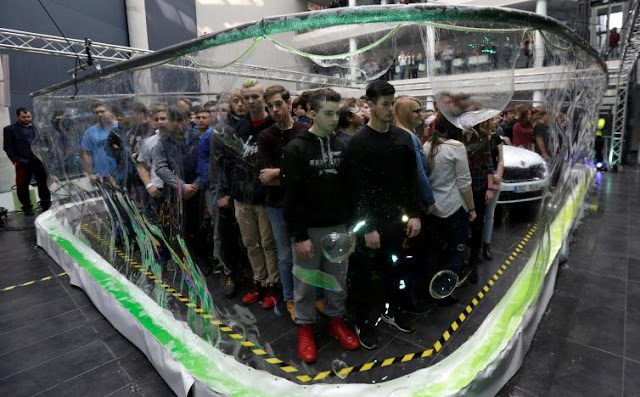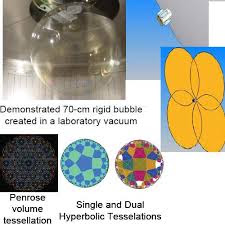Technology for making Death Star Sized Structures will have technical feasibility in the next 20 years
by noreply@blogger.com (brian wang) from NextBigFuture.com on (#29NFE)
The first Death Star had a diameter of between 140 and 160 kilometers. The second Death Star's diameter ranged from 160 to 900 kilometers.

There are two near term technologies which could be applied to making Death Star sized structures:
1. Space bubbles
2. Robotic spiderfab construction
Giant Space Bubbles
Bubbles on earth have been made that cover a rectangular 11 meter-by-7.5 meter area.

In 2007 Devon Crowe of PSI corporation created a study for NASA Advanced Innovative conceps for making large space structures from bubbles that are made rigid using metals or UV curing

A single bubble can be 10 meters in earth gravity, 100 kilometer in low earth orbit or 1000 kilometers in deep space. Foams made of many bubbles could be far larger in size.
A 140 kilometer diameter sphere would have 61600 square kilometers of surface area. If a structure could be made that was one gram per square meter, then that bubble sphere would be 61600 tons.
Reusable Spacex falcon heavy launchers could bring up the material to expand a large bubble in space. It would take about 2000 launches of a Spacex Falcon heavy to place the amount of material in orbit for a 140 kilometer sphere if the mass budget of one gram per square meter could be maintained. Every additional gram per square meter would be another 2000 launches
The size of a 1000 kilometer bubble is nearly the size of Charon, the moon of Pluto. Charon is 1200 kilometers in diameter. Saturn's moon Tethys is 1050-1080 kilometers in diameter Ceres the largest object in the asteroid belt is 970 kilometers in diameter. A single tesselation foam (like in the picture) of 1000 kilometer bubbles would be about the size of Earth's moon. A Penrose tesselation like the one in the picture of 1000 kilometer bubbles would be in between the size of Neptune or Saturn. A Tesselation foam of 100 kilometer bubbles in earth orbit could form an object the size our existing moon or larger.
A tesselation of many bubbles would make a large death star size structure that would be more resilient than the movie Death Star. The Death Star was destroyed with one well placed shot. Thousands of bubbles would need thousands of shots to destroy. Very low pressure or no pressure inside bubbles would mean that bubbles would not pop with a hole.
Metal can be evaporated to coat the inside of the bubble for reflective sails and telescopes. A reflective giant space bubble could be used to focus sunlight into a beam.
Russian theorists had proposed solar reflector systems that could constantly illuminate areas the size of several cities every night. The most ambitious proposal foresees a constellation of 100 reflectors, each 1,300 feet in diameter with a surface area of 30 acres.
The Nazi considered making giant mirrors to heat cities to several hundred degrees.

Read more











There are two near term technologies which could be applied to making Death Star sized structures:
1. Space bubbles
2. Robotic spiderfab construction
Giant Space Bubbles
Bubbles on earth have been made that cover a rectangular 11 meter-by-7.5 meter area.

In 2007 Devon Crowe of PSI corporation created a study for NASA Advanced Innovative conceps for making large space structures from bubbles that are made rigid using metals or UV curing

A single bubble can be 10 meters in earth gravity, 100 kilometer in low earth orbit or 1000 kilometers in deep space. Foams made of many bubbles could be far larger in size.
A 140 kilometer diameter sphere would have 61600 square kilometers of surface area. If a structure could be made that was one gram per square meter, then that bubble sphere would be 61600 tons.
Reusable Spacex falcon heavy launchers could bring up the material to expand a large bubble in space. It would take about 2000 launches of a Spacex Falcon heavy to place the amount of material in orbit for a 140 kilometer sphere if the mass budget of one gram per square meter could be maintained. Every additional gram per square meter would be another 2000 launches
The size of a 1000 kilometer bubble is nearly the size of Charon, the moon of Pluto. Charon is 1200 kilometers in diameter. Saturn's moon Tethys is 1050-1080 kilometers in diameter Ceres the largest object in the asteroid belt is 970 kilometers in diameter. A single tesselation foam (like in the picture) of 1000 kilometer bubbles would be about the size of Earth's moon. A Penrose tesselation like the one in the picture of 1000 kilometer bubbles would be in between the size of Neptune or Saturn. A Tesselation foam of 100 kilometer bubbles in earth orbit could form an object the size our existing moon or larger.
A tesselation of many bubbles would make a large death star size structure that would be more resilient than the movie Death Star. The Death Star was destroyed with one well placed shot. Thousands of bubbles would need thousands of shots to destroy. Very low pressure or no pressure inside bubbles would mean that bubbles would not pop with a hole.
Metal can be evaporated to coat the inside of the bubble for reflective sails and telescopes. A reflective giant space bubble could be used to focus sunlight into a beam.
Russian theorists had proposed solar reflector systems that could constantly illuminate areas the size of several cities every night. The most ambitious proposal foresees a constellation of 100 reflectors, each 1,300 feet in diameter with a surface area of 30 acres.
The Nazi considered making giant mirrors to heat cities to several hundred degrees.

Read more